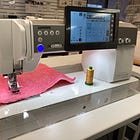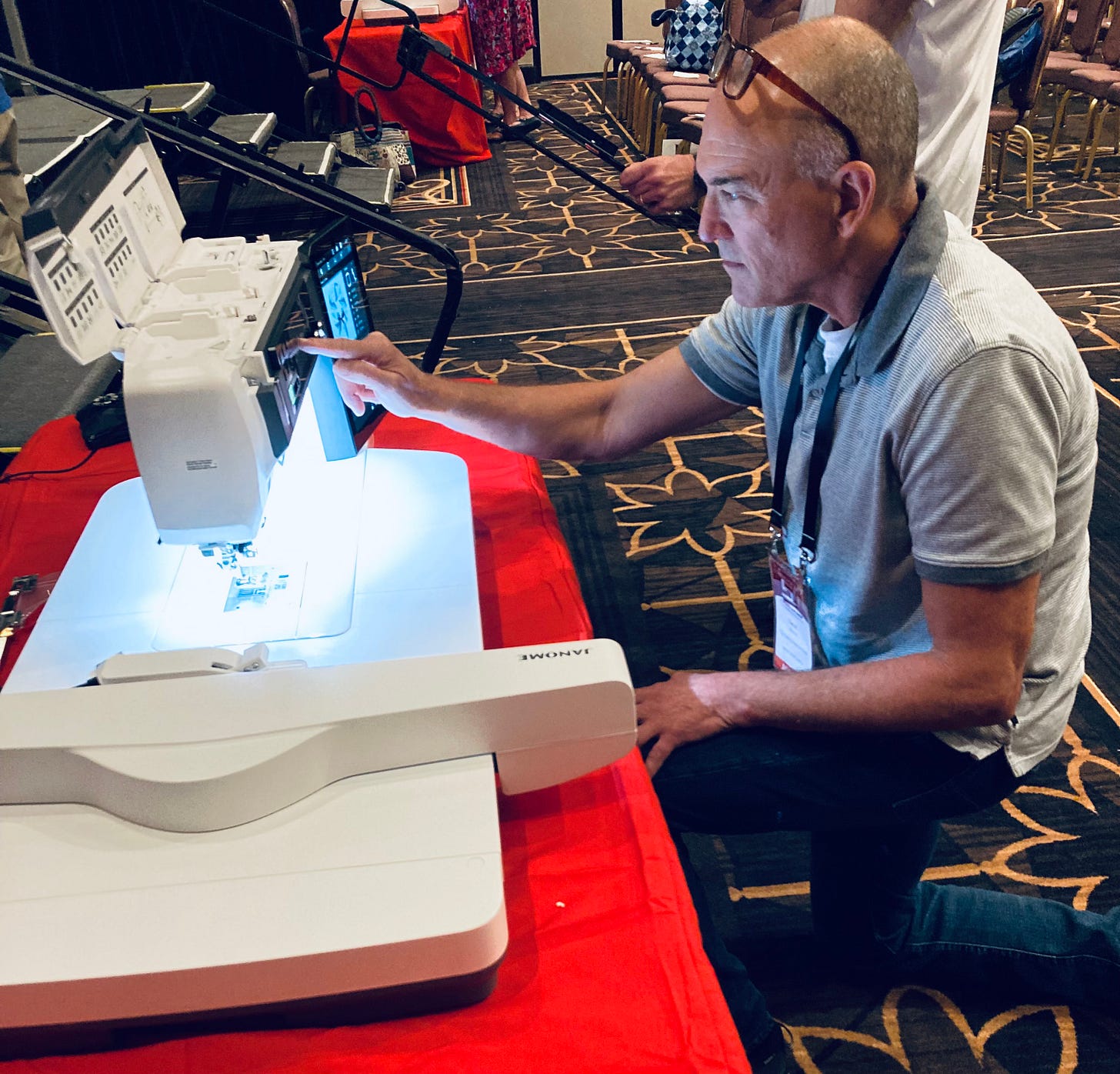Dear Janome Engineering Japan...
12 Questions for the engineers who design your sewing machines, asked by The Question Man himself!
Greetings everybody,
As a sewing machine dealership that prioritizes quality products, we are a big fan of Janome, a Japanese sewing machine manufacturer that often flies under the radar of the general sewing community.
In April 2022, my dad and I visited Las Vegas to attend a massive sewing machine convention. It was particularly exciting because Janome was unveiling their new top-of-the-line machine, the Continental M17, the first ever flatbed machine capable of both sewing and embroidery, as well as the first home machine outside Bernina to have stitch regulation for free-motion quilting.
When the M17 was unveiled, most of the other dealerships had their phones and cameras out to film videos of them with the M17 to post on their social media. But my dad is an old-school guy, not big on social media at all. He studied aeronautical engineering in college and is an engineer at heart, so when it was his turn to look at the machine, he didn’t take any videos or pictures or anything like that. Instead, he got one knee and played with the machine for a good 15 minutes, sewing on it, testing out its capabilities, examining critical components like the needle bar girth, needle threader quality, and the powder-coated frame. He even asked a Janome director for a Phillips screwdriver so that he could remove the top cover and get a look at the upper shaft, but they said no.
There was another moment, later on at the convention, that encapsulated my father to a tee. Janome hosted another event, this time with a few of their social media personalities and content creators showing off features like the Janome stitch regulator system. Again, most of the other dealerships were taking videos and pictures of the demonstration, and my intuition was to follow suit and get a video of my dad talking about the beauty of stitch regulation as it was being demoed, but my dad was nowhere to be found. I finally located him on the other side of the convention center, deep in conversation with a handful of Janome engineers who had flown all the way from Japan to Las Vegas for the unveiling of their new product.
Afterward, my dad explained to me that there was a bit of a language barrier between him and the Japanese engineers, so he had difficulty communicating some of his questions. However, one of the head honchos at Janome America told him that if he sent in a list of questions, Janome could translate the questions to Japanese and pass them along to the engineers at their Research and Development Center in Hachioji.
Well, 2 years later my dad finally got around to composing his full list of questions. Although we have yet to receive an answer, I want to share them with you because the questions themselves are incredibly informative. One of the skills my father possesses is that he is really good at asking questions. It is a trait I admire in him and hope to have inherited. If you read on, I think it will become clear why he has been nicknamed “The Question Man” by various friends and family.
Now, without further adieu, here is the email of 12 questions Dan sent to Janome America's headquarters to be passed along to Janome’s engineers in Japan.
I hope you enjoy.
-Cale
Dear Janome Engineering Japan,
Our company writes technical articles for serious sewers and helps them choose the correct sewing machine to purchase based on budget and need. We absolutely love Janome sewing machines and want to educate them on why Janome sewing machines are such a good value based on performance, ease of use, and reliability. They have a genuine interest in how sewing machines are made and what makes one brand of sewing machine better than another. We want to present to them an interview with the actual men and women who produce this fine product. We have put together a series of questions that are more technical in nature than what is usually readily available on the internet. We have found that consumers really enjoy these in-depth articles and respond by purchasing those products they understand the most. Thank you again for your thoughtful answers to the following questions:
1- Janome is the only company to date that has produced multi-stitch flatbed sewing machines starting with the model 6500 many years ago, all the way up to the current flagship M17. Can you tell us what design advantages a flatbed has over a free-arm machine? We know that a free arm limits available space for a design engineer. How does the extra space of the flatbed allow engineers to increase overall performance?
2- Starting with the Continental M7, Janome introduced a unique brushless servo motor. We know that a brushless servo will last longer but we have had little issue with traditional motors wearing out. Sewing machine motors have always been one of the more reliable components on a sewing machine. Can you tell us how your specific brushless servo motor on the M series provides more power at the needle to sew heavy fabrics? Are there any other benefits besides longevity? Please feel free to give us a technical explanation on how it differs from traditional sewing motors.
3- Janome seems to be the only company using sealed ball bearings in their sewing machines. In the past, we did have problems with traditional upper left shaft bushing on the Janome 8000,9000,10000 series. The shaft would heat up and burn causing carbon build-up, binding the machine. These were machines that did embroidery and often had high stitch counts. We notice that you solved this issue with the sealed bearings on the upper left shaft. Can you tell us why you do not put them on both the right and left of the top and bottom shaft?
4- We notice that the model 5300QDC has a larger needle bar diameter and it appears that it has larger feed and zig-zag step motors than the 3160 and 4120 even though they appear to be built on the same platform. In other words, it has improved components. Are the step motors more powerful? Can you educate us a bit more on the different step motor specifications that Janome puts into their sewing machines? Please feel free to get technical. For example, how does the step motor in your model 3160QDC differ from the step motor in your Continental M8? What specification values increase a step motor's performance?
5- Pfaff produced the first dual-feed (walking foot) sewing machine 50 years ago with its model 1222. It was a very important innovation that fixed an ongoing issue of transporting multiple layers of fabric without having ply shifting. Bernina introduced a very similar design with its 7 series machines many years later that was almost identical to Pfaffs. Janome introduced their version of dual feed with the model 6600 and later modified the design with the 8200,8900, 12000 etc... Can you tell us why you chose the current unique Janome design as opposed to using the Pfaff/Bernina design? Do you think the Janome design is superior?
Keep reading with a 7-day free trial
Subscribe to The Sewing Machine Newsletter to keep reading this post and get 7 days of free access to the full post archives.








